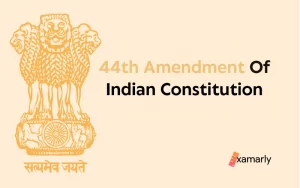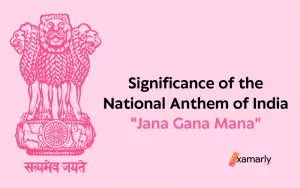The National Flag of India is a patriotic symbol. As citizens of India, we attach a certain patriotic value to it. The sight of the Tri-color blowing in the breeze, outside the Red Fort, on the Olympic grounds, or up high on Mount Everest, fills us up with pride.
This article on “The national flag of India- information, facts and more” will provide you with the Indian flag details which will be very helpful from the UPSC exam point of view.
The National Flag of India is a Tri-color. It is a horizontal rectangle in shape and consists of saffron, white and green. It has the symbol of the Asoka Chakra, a 24-spoke wheel in navy blue.
It has been the symbol of the Indian state since independence. Historically, it has played a prominent role in the national freedom struggle. It has remained a symbol of unity and togetherness ever since the nation was freed in 1947.
Beyond these basics, do we really know about our national pride, the tiranga? Do we know its history, code of conduct, and what it stands for? If not, then you have come to the right place. Read on to know more.
About Indian Flag
Let us now delve deeper into information and details related to the national flag of India.
The Tricolour
The national flag of India is a horizontal Tri-colour. It consists of horizontal bands of deep saffron, white and dark green with the navy blue Asoka Chakra at its centre.
During a meeting of the Constituent Assembly held on 22 July 1947, the Tri-colour was adopted as the national or official flag of India. It is based on the Swaraj flag of the Indian National Congress which was designed by agriculturist and Indian freedom fighter Pingali Venkayya as a means to recognize the national struggle for freedom from British rule.
The specifications along with its manufacturing process are laid out by the Bureau of Indian Standards (BIS). Let us look at some of these features below.
Colour and Size
The width: height ratio of the National Flag of India is of a specific size. This specified ratio given in the Indian Flag Code is 3:2.
Here, each colour band is of equal proportion and the Asoka Chakra has 24 evenly placed spikes. The saffron colour (India saffron or Kesari) strip on top represents courage and sacrifice.
The white colour strip or the middle band symbolizes peace, truth, and purity. The dark green colour (India green) strip on the bottom represents the prosperity of the land. The center white band contains a navy blue wheel Ashok chakra which represents the Laws of Dharma.
The flag is manufactured in nine sizes (maintaining the proposition), starting with the smallest six by four-inch flag to the largest 21×14 feet flag.
Fabric Cloth and Manufacture
The design and manufacturing details are followed in accordance with 3 documents issued by the Bureau of Indian Standards.
Till, December 2021, the flag of India was always made from khadi or hand-spun cloth. The raw materials in the production of khadi should be limited to cotton, silk, and wool. In December 2021 machine manufacturing as well as the use of alternative materials including polyester, non-khadi cotton, or silk was allowed as per an amendment by the Indian Government.
Manufacturing of the flag is delegated to the Khadi Development and Village Industries Commission. This body reassigns the work to regional flag manufacturing units. Two districts in Karnataka supply the woven khadi for the national flag. These districts are Dharwad and Bagalkot.
This woven material is sent to the BIS for quality testing of the material and once approved is returned to the factory. Since 2009, the Karnataka Khadi Gramodyoga Samyukta Sangha has been bestowed with the right and recognition as the sole manufacturer.
Related Reading: Significance of the National Anthem of India “Jana Gana Mana”
National Flag of India: Information and History
The first flag to be made in India was in 1906. It has undergone several modifications since its inception.
The removal of religious symbols and inclusion of secular elements has been notable modifications over years. Let us look at a few such momentous developments over history:
Indian Flag in 1906
The first Indian flag was designed by Sister Nivedita, a disciple of Swami Vivekananda. It was composed of three equal stripes of colour and contained a yellow star, a red crescent, a white lotus, and the Bengali word ‘Bonde Matoram’.
The flag was originally and unofficially hoisted in Calcutta on August 7, 1906, during a boycott related to the partition of Bengal.
This flag is based on the Calcutta Flag, Bhikaji Cama raised the “Flag of Indian Independence” on August 22, 1907, at the International Socialist Conference in Stuttgart, Germany.
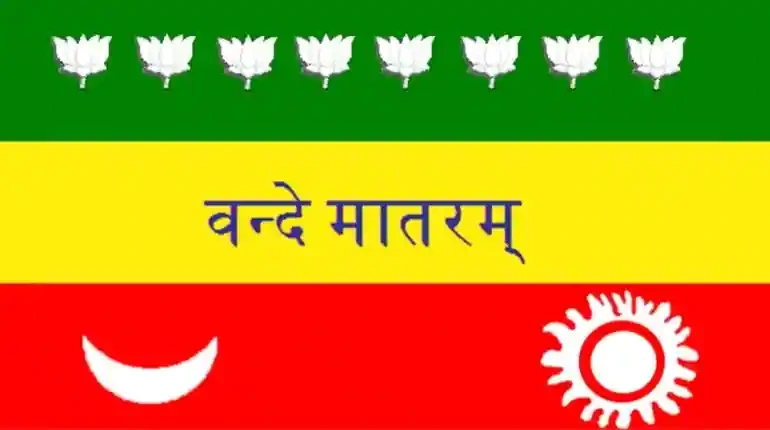
Indian Flag in 1907
Madam Bhikaji Rustom Cama (a socialist activist from Gujarat), Vinayak Damodar Savarkar, and Shyamji Krishna Varma are credited with designing this flag.
It is made of three colours – green, golden saffron, and red. It featured eight blooming lotuses on top and a rising sun and crescent moon on the bottom.
In 1907, it was unfurled at the International Socialist Congress in Stuttgart, Germany. Thus, it became the second to be hoisted in India as well as the first to be hoisted on foreign soil.
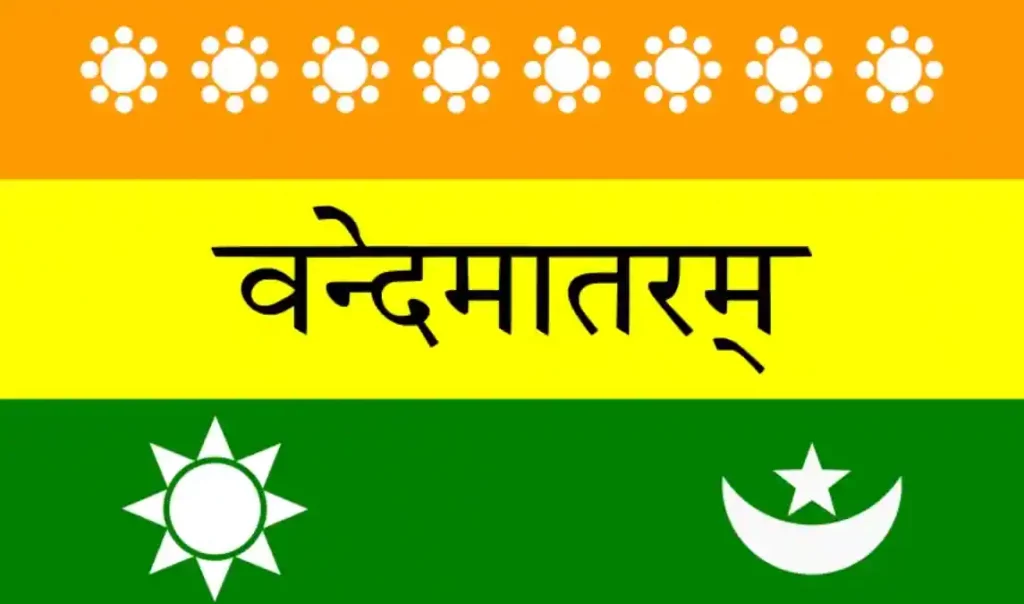
Indian Flag in 1916
In 1916, Pingali Venkayya was funded by the High Court of Madras to produce designs for the national flag. He submitted a booklet containing 30 designs for the same.
One of the designs was made of two colours and had a chakra drawn in the middle (as per Gandhi’s suggestion). But Gandhiji was not fully satisfied with the design as the two colours represented Hindus and Muslims but there was no colour to symbolize the other religious communities.
Indian Flag in 1917
The third flag to be hoisted was in 1917 during the Home Rule movement. It was raised by Bal Gangadhar Tilak and Dr. Annie Besant.
It comprised a Union Jack at the top left corner, near the hoist. It was made of horizontal stripes of five red and four green bands. It also had the Saptarishi and a crescent moon with stars to symbolize religious elements.

Gandhi’s Flag in 1921
In 1921, a draft design was presented by Pingali Venkayya to Mahatma Gandhi at a session of the All India Congress Committee in Vijayawada. The draft design later became the Indian flag. It was adopted by the government before the independence of the country in 1947.
Mahatma Gandhi suggested a Tri-coloured flag with a spinning wheel symbol in it. This would symbolize the two major religions in the Indian subcontinent along with a third colour to symbolize the minorities. The colours were white, green and red (from top to bottom) with the charka covering all three stripes.

Swaraj Flag in 1931
The Indian National Congress adopted a Tricolour flag before the country achieved independence. It was adopted in the Congress Committee Meeting as a symbol for the committee and was first hoisted on 31 August 1931.
The Tricolour had white, green, and saffron stripes with a spinning wheel in the centre. The replacement of red with saffron was a planned decision to overthrow religious connotations as orange was representative of Hindu yogis as well as Muslim darvesh.

Indian Flag in 1947
Post the Indian Independence Movement, before India gained Independence, a committee met to select the Indian National Flag. It was headed by Rajendra Prasad and included members Maulana Abul Kalam Azad, Sarojini Naidu, C. Rajagopalachari, K.M. Munshi, and B.R. Ambedkar.
Modifications were made to the existing Indian Nation Congress flag (as designed in 1931) wherein the charkha (spinning wheel) in the middle was replaced with a chakra (wheel). It was to be stripped of any religious or communal meanings and hence the three colours became representative of qualities rather than communities of India.
Jawaharlal Nehru proposed this Tricolour flag of deep saffron, white and dark green with the blue Ashoka wheel in the centre at the Constituent Assembly on 22 July 1947.
The resolution was approved unanimously. In official terms, it became the national fag of the Dominion of India from 15 August 1947 to 26 January 1950. It has further served as the flag of the Republic of India ever since.
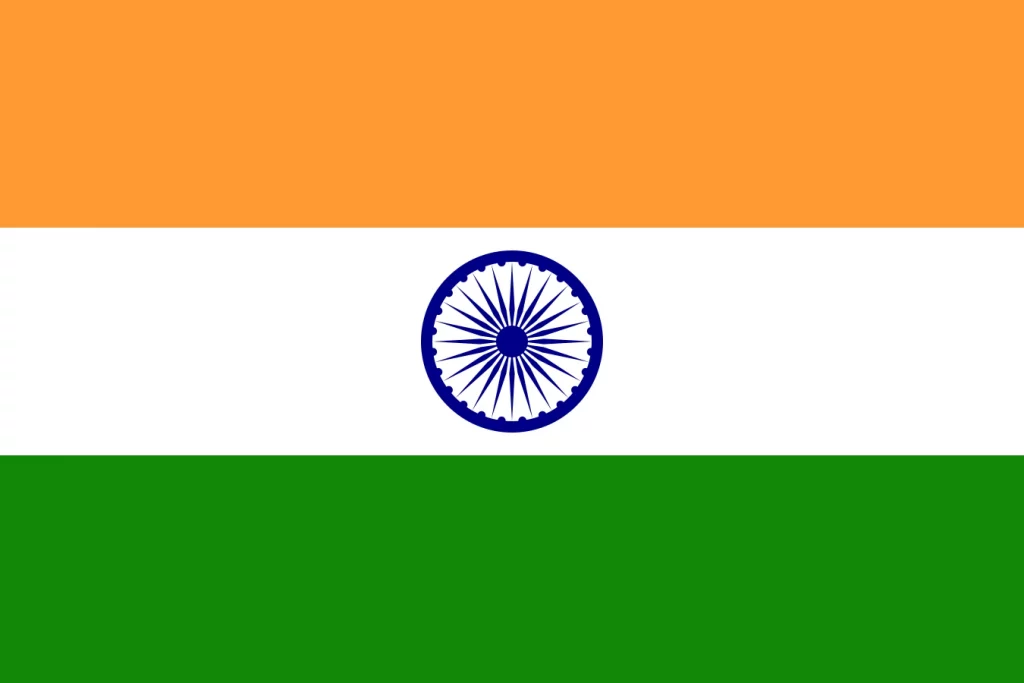
Importance of the National Flag of India
- First and foremost, it is a national symbol of the free country of India. It symbolically stands for the struggles and sacrifices India and its citizens had to make in the freedom movement in order to attain its current state of democratic freedom.
- It is a sign of patriotism that can induce a sense of pride in India and its achievements. This is why the sight of the national flag of India in war, international events, or any public gathering induces a sense of respect and honour.
- It represents the Unity of the people of India, despite and all-inclusive of its religious, political, social, economic, and cultural differences.
Significance of Colors
At the time of its inception, the Tricolour was supposed to have communal undertones and religious significance. But, with time, this idea has been stripped and replaced with qualities and symbols of the country’s identity and heritage. Each element has symbolic meanings and distinctive features.
The colour saffron represents bravery, selflessness, and renunciation. Colour saffron is also a common religious colour that represents renunciation and absolution from the ego. It also reminds political leaders to dedicate their work to the nation and its people.
The green colour symbolizes prosperity and the richness of the land. It is a reminder of the fertility of the soil. Thus the colour represents the fertility, growth, and auspiciousness of India.
The white stripe represents peace, truth, and purity.
The Asoka Chakra is the symbol of the supreme truth. Inspired by the Hindu symbol Dharma Chakra, it symbolizes movement, which is important for life. This wheel is also said to represent the progress or economic regeneration of the country. The 24 evenly-spaced spokes represent the twenty-four hours in a day.
You Might Also Like: Social Reformers of India | Social Reform Movements In India
Facts about the Indian Flag
- The Constituent Assembly adopted the Tricolour as the national or official flag of India after holding a meeting. It was held on July 22, 1947.
- It is based on the Swaraj flag of the Indian National Congress which was designed by agriculturist and Indian freedom fighter Pingali Venkayya.
- Supreme Court declared the right to hoist a flag as the fundamental right under Article 19 (i) (a) of the Indian Constitution in 2002.
- It was raised on Mount Everest on May 29, 1953, when Edmund Hillary and Sherpa Tenzing Norgay conquered Mount Everest.
- It made its appearance in space along with Wing Commander Rakesh Sharma who was the first Indian in space. It was attached as a medallion on the space suit worn by Rakesh Sharma.
Code of Conduct
As responsible Indian citizens, it is pertinent that we know the dos and don’ts of the Indian flag.
- It should always be raised with the colour saffron band on top.
- Care must be taken to avoid the placing of any other emblem or flag towards the right or above the flag.
- When displayed with other flags, the National Flag must always be hung to the left.
- The National Flag must always be on the right side of a procession or parade, or at the head of the line if there is one.
- It should not be used as a clothing item.
- It is hoisted over important government offices buildings like the Rashtrapati Bhawan, the Parliament House, the Supreme Court of India, the High Courts, the Secretariats, and the Commissioners’ office.
- It is also flown in the state of origin for the Speaker of the Lok Sabha and the Chief Justice of the Supreme Court.
- It should always be lowered in the evening at sunset.
- It should be flown at half-mast in situations of deceased dignitary like in the event of the death of the Indian Prime Minister or Vice President or Chief Minister of a State.
- It cannot be flown half-mast on Republic Day, Independence Day, and Gandhi Jayanti except over buildings housing the bodies of deceased dignitaries.
- As per the amendment of the Flag Code in 2002, Individual citizens may also hoist/display the Indian National Flag on their premises.
Also Read: Female National Leaders Of India
Conclusion
The national flag is a symbolic representation of India as a free and democratic state. It is also a crucial part of India’s freedom struggle and identity as an independent nation.
Hence, it is pertinent for every citizen of the country, especially aspirants of UPSC to know everything about the Tri-colour. Hope this article has helped you learn about the details of the Indian flag.
FAQs about the National Flag of India
Who designed the present National Flag of India?
The present national flag of India was designed by Pingali Venkayya.
Who approves the design and production of the National Flag of India?
The Bureau of Indian Standards (BIS) governs the design and production of the flag of India. It does so by means of three documents released by BIS.
Why was Ashok Chakra adopted?
To symbolize Dharma and Law, the Ashok Chakra or Ashoka Chakra or Asoka Chakra in blue colour was chosen on the white stripe of the national flag.
Why are there 24 spokes in Ashoka Chakra?
Love, courage, patience, magnanimity, goodness, faithfulness, gentleness, self-control, self-sacrifice, truthfulness, righteousness, justice, mercy, gracefulness, humility, empathy, sympathy, spiritual Knowledge, moral values, spiritual wisdom, the fear of God and faith (belief or hope) are all represented by all 24 spokes.
What is the National Flag of India called?
It is referred to as the Tiranga or Tricolor Flag because it features Tri-colours, (green, white, and saffron stripes) the national flag of India.




